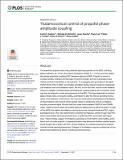| dc.contributor.author | Soplata, Austin E. | |
| dc.contributor.author | McCarthy, Michelle M. | |
| dc.contributor.author | Sherfey, Jason | |
| dc.contributor.author | Lee, Shane | |
| dc.contributor.author | Purdon, Patrick L. | |
| dc.contributor.author | Kopell, Nancy | |
| dc.contributor.author | Brown, Emery Neal | |
| dc.date.accessioned | 2018-09-21T15:41:38Z | |
| dc.date.available | 2018-09-21T15:41:38Z | |
| dc.date.issued | 2017-12 | |
| dc.date.submitted | 2017-09 | |
| dc.identifier.issn | 1553-7358 | |
| dc.identifier.issn | 1553-734X | |
| dc.identifier.uri | http://hdl.handle.net/1721.1/118161 | |
| dc.description.abstract | The anesthetic propofol elicits many different spectral properties on the EEG, including alpha oscillations (8–12 Hz), Slow Wave Oscillations (SWO, 0.1–1.5 Hz), and dose-dependent phase-amplitude coupling (PAC) between alpha and SWO. Propofol is known to increase GABAAinhibition and decrease H-current strength, but how it generates these rhythms and their interactions is still unknown. To investigate both generation of the alpha rhythm and its PAC to SWO, we simulate a Hodgkin-Huxley network model of a hyperpolarized thalamus and corticothalamic inputs. We find, for the first time, that the model thalamic network is capable of independently generating the sustained alpha seen in propofol, which may then be relayed to cortex and expressed on the EEG. This dose-dependent sustained alpha critically relies on propofol GABAApotentiation to alter the intrinsic spindling mechanisms of the thalamus. Furthermore, the H-current conductance and background excitation of these thalamic cells must be within specific ranges to exhibit any intrinsic oscillations, including sustained alpha. We also find that, under corticothalamic SWO UP and DOWN states, thalamocortical output can exhibit maximum alpha power at either the peak or trough of this SWO; this implies the thalamus may be the source of propofol-induced PAC. Hyperpolarization level is the main determinant of whether the thalamus exhibits trough-max PAC, which is associated with lower propofol dose, or peak-max PAC, associated with higher dose. These findings suggest: the thalamus generates a novel rhythm under GABAApotentiation such as under propofol, its hyperpolarization may determine whether a patient experiences trough-max or peak-max PAC, and the thalamus is a critical component of propofol-induced cortical spectral phenomena. Changes to the thalamus may be a critical part of how propofol accomplishes its effects, including unconsciousness. | en_US |
| dc.publisher | Public Library of Science (PLoS) | en_US |
| dc.relation.isversionof | http://dx.doi.org/10.1371/JOURNAL.PCBI.1005879 | en_US |
| dc.rights | Creative Commons Attribution 4.0 International License | en_US |
| dc.rights.uri | http://creativecommons.org/licenses/by/4.0/ | en_US |
| dc.source | Springer | en_US |
| dc.title | Thalamocortical control of propofol phase-amplitude coupling | en_US |
| dc.type | Article | en_US |
| dc.identifier.citation | Soplata, Austin E. et al. “Thalamocortical Control of Propofol Phase-Amplitude Coupling.” Edited by Lyle J. Graham. PLOS Computational Biology 13, 12 (December 2017): e1005879 © 2017 Soplata et al | en_US |
| dc.contributor.department | Massachusetts Institute of Technology. Department of Brain and Cognitive Sciences | en_US |
| dc.contributor.mitauthor | Brown, Emery Neal | |
| dc.relation.journal | PLOS Computational Biology | en_US |
| dc.eprint.version | Final published version | en_US |
| dc.type.uri | http://purl.org/eprint/type/JournalArticle | en_US |
| eprint.status | http://purl.org/eprint/status/PeerReviewed | en_US |
| dc.date.updated | 2018-09-19T15:49:38Z | |
| dspace.orderedauthors | Soplata, Austin E.; McCarthy, Michelle M.; Sherfey, Jason; Lee, Shane; Purdon, Patrick L.; Brown, Emery N.; Kopell, Nancy | en_US |
| dspace.embargo.terms | N | en_US |
| dc.identifier.orcid | https://orcid.org/0000-0003-2668-7819 | |
| mit.license | PUBLISHER_CC | en_US |
